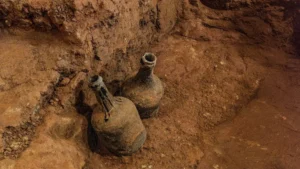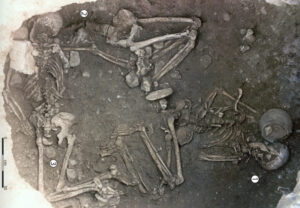Many believe that Western civilization began in ancient Greece, with the great minds of Plato, Aristotle, and Archimedes. It turns out that humans had a lot longer to develop in Greece than previously thought.
New discoveries have pushed back the dawn of the Greeks by a quarter of a million years. In an open lignite mine, 200 kilometers southwest of Athens, a number of hunting tools have turned up that date to 700,000 years ago. Prior to this, the oldest tools in Greece came from the Petralona Cave in the north of the country and were just 500,000 years old.

Part of an ancient deer skull found at the Kyparissia site 4. Photo: Greek Culture Ministry
Archaeologists have known of this site in the Megalopolis Basin for many years but have only rarely excavated it. Mainly, the area has supplied coal to local power plants. When more mining took place, it revealed five new sites in the basin. It eventually became clear that there were older remains and fossils there.
This triggered an attempt to better understand the sites. The Hellenic Ministry of Culture & Sports and the American School of Classical Studies teamed up for a planned five-year study.
One of the five new discoveries, Kyparissia 4, lies 70 meters below the surface. It contains stone hunting tools and the remains of hippos, rhinos, and elephants. This is the one that dates back 700,000 years and is the oldest Lower Palaeolithic site in Greece.
“[It’s] one of the oldest sites in Europe with tools characteristic of the so-called Middle Palaeolithic tool industry,” the researchers told The Guardian. It suggests that Greece may have played a significant role in stone industry developments in Europe.
Possibly a pre-human site
We can’t be sure if Homo sapiens were present 700,000 years ago, but the tools indicate that if they weren’t, our earlier hominin ancestors were roaming Greece at the time. Katerina Harvati, co-leader of the project, said, “The Megalopolis basin provides a crucial piece of the puzzle of human evolution in Europe.”
Even though this is now the oldest hominin site in Greece, it is not the oldest in Europe. In Spain, some sites are over one million years old.

Stone tools crafted by hominins from the Kyparissia 4 site. Photo: Greek Culture Ministry
Reconstructions of the basin and environment show that the area would not have been affected by the Ice Age that covered large swathes of Europe 300,000 to 500,000 years ago. Instead, the basin acted as a safe haven for species, allowing them to survive and evolve.
Across the Megalopolis basin, the team found tools, a number of fossils, and the remains of large and small animals, plants, and insects. It is not only a look into the history of human evolution but of any other species.
In the Choremi 7 site, dating to 280,000 years ago, they found tools and deer bones with obvious cut marks. The 400,000-year-old Tripotamos 4 site showed evidence of ever-improving stone tools. And the 450,000-year-old Marathons] 1 and 2 areas had ancient human remains and elephants that had clearly been killed using the tools.






